Academic Skills for Accountants - Business Finance Assignment
VerifiedAdded on 2020/04/13
|15
|2918
|74
Homework Assignment
AI Summary
This assignment, titled "Academic Skills for Accountants," addresses key concepts relevant to accounting and finance professionals. Task 1 explores different types of business organizations, including sole proprietorships, partnerships (with various types like general, limited, and limited liability partnerships), and corporations (private and public). It highlights the advantages and disadvantages of each structure, focusing on aspects such as liability, ownership, and operational complexities. Task 2 delves into microeconomic principles, starting with marginal utility and the law of diminishing marginal utility, explaining their significance in economic theory. It then examines price elasticity of demand, defining its measurement and illustrating how the demand for goods responds to price changes. The assignment provides a comprehensive analysis of these concepts, offering valuable insights into business operations and economic decision-making.
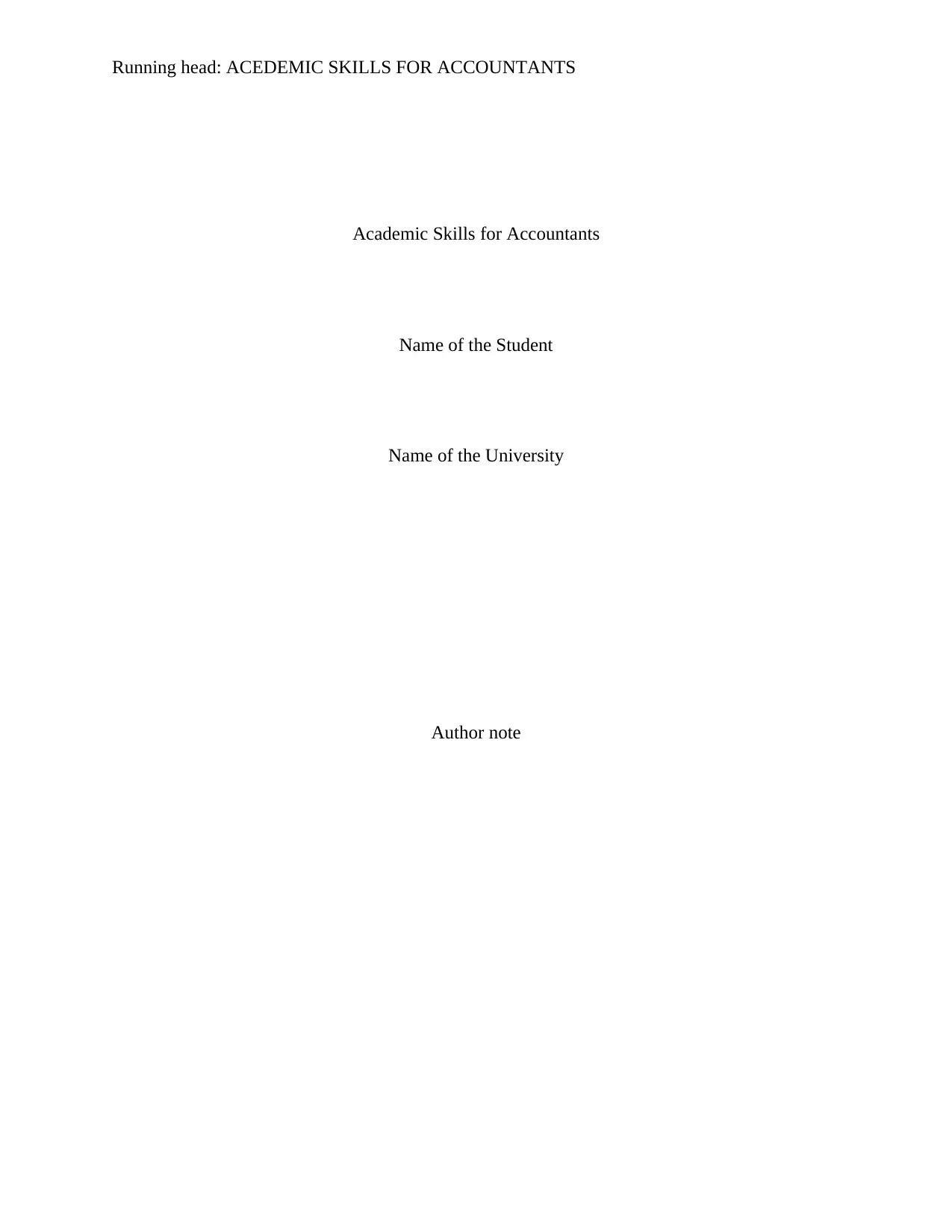
Running head: ACEDEMIC SKILLS FOR ACCOUNTANTS
Academic Skills for Accountants
Name of the Student
Name of the University
Author note
Academic Skills for Accountants
Name of the Student
Name of the University
Author note
Paraphrase This Document
Need a fresh take? Get an instant paraphrase of this document with our AI Paraphraser
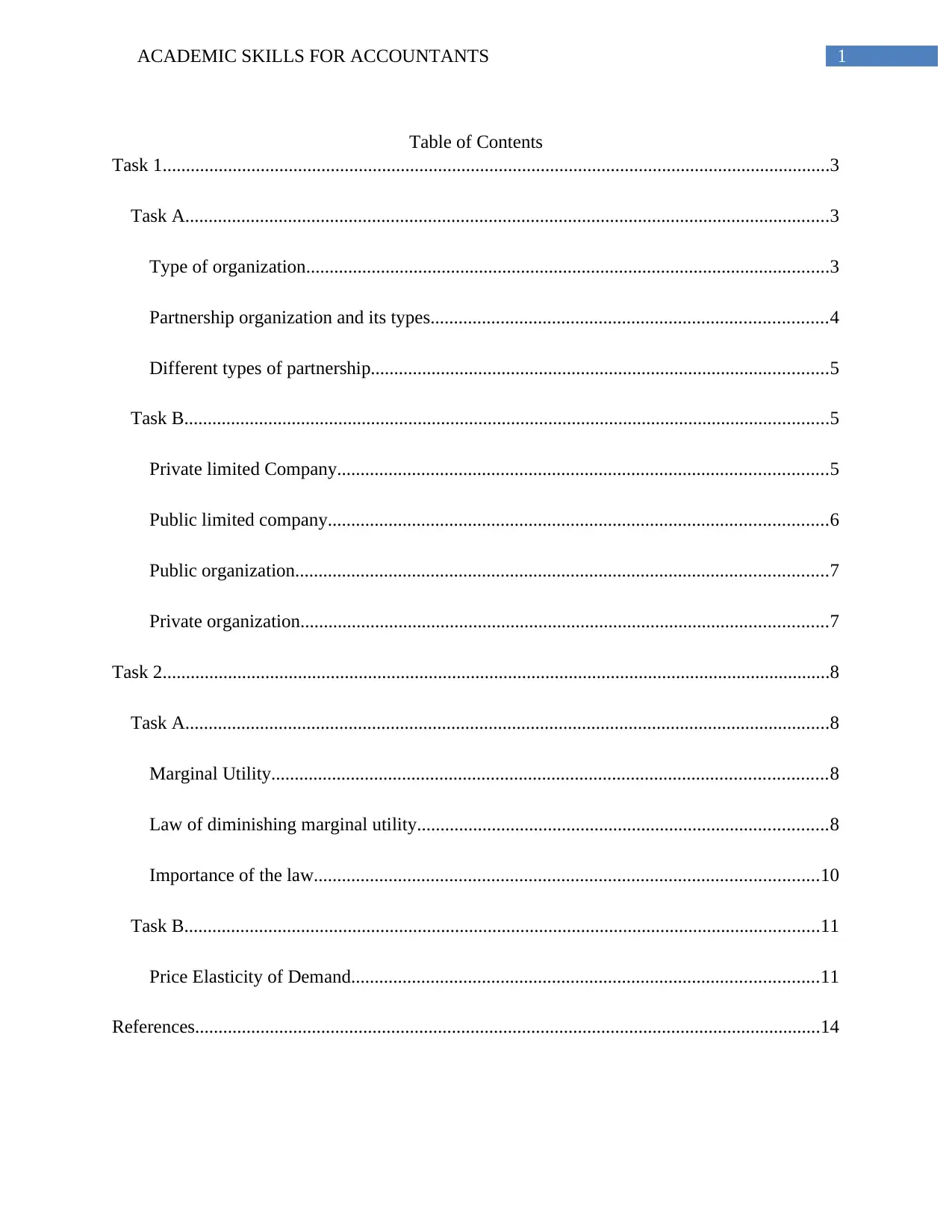
1ACADEMIC SKILLS FOR ACCOUNTANTS
Table of Contents
Task 1...............................................................................................................................................3
Task A..........................................................................................................................................3
Type of organization................................................................................................................3
Partnership organization and its types.....................................................................................4
Different types of partnership..................................................................................................5
Task B..........................................................................................................................................5
Private limited Company.........................................................................................................5
Public limited company...........................................................................................................6
Public organization..................................................................................................................7
Private organization.................................................................................................................7
Task 2...............................................................................................................................................8
Task A..........................................................................................................................................8
Marginal Utility.......................................................................................................................8
Law of diminishing marginal utility........................................................................................8
Importance of the law............................................................................................................10
Task B........................................................................................................................................11
Price Elasticity of Demand....................................................................................................11
References......................................................................................................................................14
Table of Contents
Task 1...............................................................................................................................................3
Task A..........................................................................................................................................3
Type of organization................................................................................................................3
Partnership organization and its types.....................................................................................4
Different types of partnership..................................................................................................5
Task B..........................................................................................................................................5
Private limited Company.........................................................................................................5
Public limited company...........................................................................................................6
Public organization..................................................................................................................7
Private organization.................................................................................................................7
Task 2...............................................................................................................................................8
Task A..........................................................................................................................................8
Marginal Utility.......................................................................................................................8
Law of diminishing marginal utility........................................................................................8
Importance of the law............................................................................................................10
Task B........................................................................................................................................11
Price Elasticity of Demand....................................................................................................11
References......................................................................................................................................14
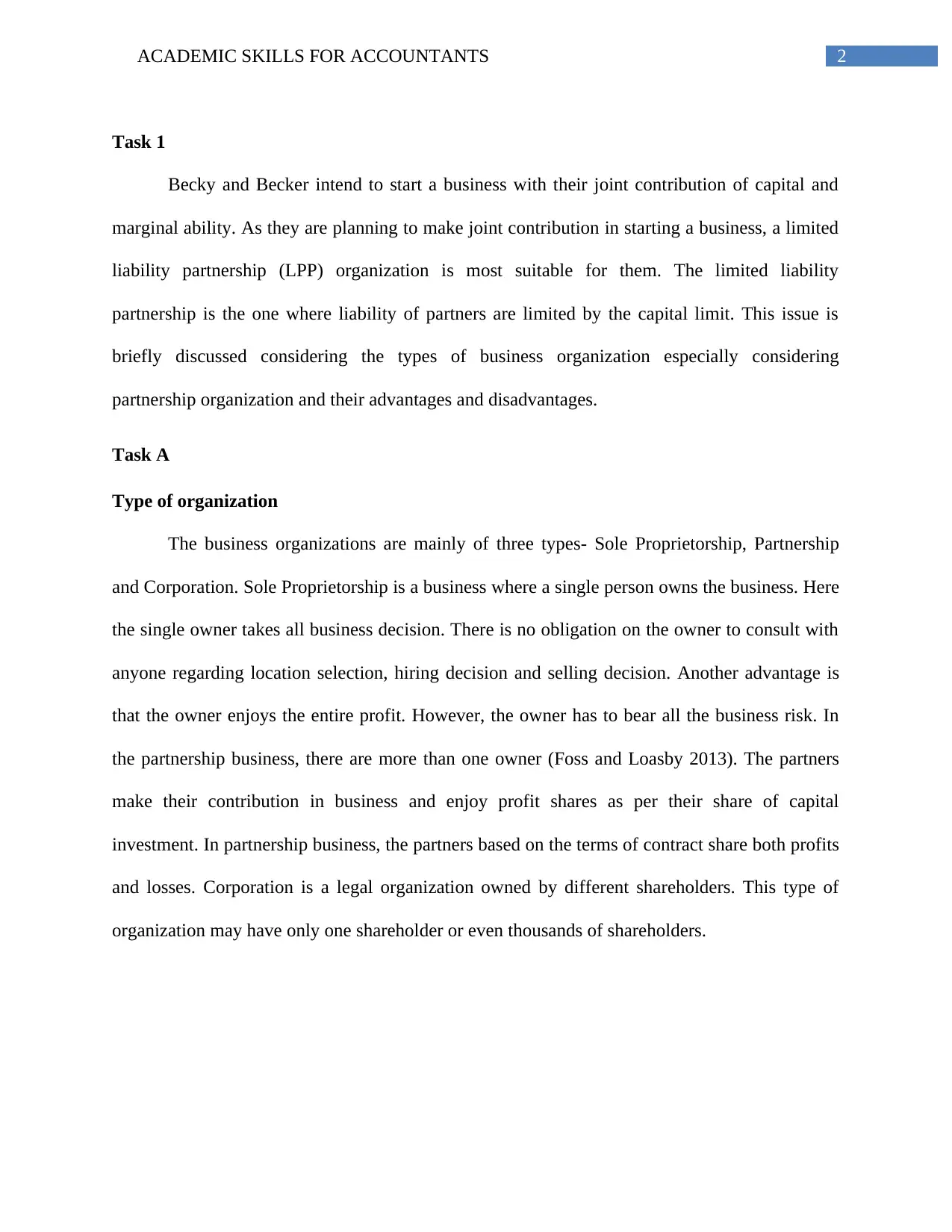
2ACADEMIC SKILLS FOR ACCOUNTANTS
Task 1
Becky and Becker intend to start a business with their joint contribution of capital and
marginal ability. As they are planning to make joint contribution in starting a business, a limited
liability partnership (LPP) organization is most suitable for them. The limited liability
partnership is the one where liability of partners are limited by the capital limit. This issue is
briefly discussed considering the types of business organization especially considering
partnership organization and their advantages and disadvantages.
Task A
Type of organization
The business organizations are mainly of three types- Sole Proprietorship, Partnership
and Corporation. Sole Proprietorship is a business where a single person owns the business. Here
the single owner takes all business decision. There is no obligation on the owner to consult with
anyone regarding location selection, hiring decision and selling decision. Another advantage is
that the owner enjoys the entire profit. However, the owner has to bear all the business risk. In
the partnership business, there are more than one owner (Foss and Loasby 2013). The partners
make their contribution in business and enjoy profit shares as per their share of capital
investment. In partnership business, the partners based on the terms of contract share both profits
and losses. Corporation is a legal organization owned by different shareholders. This type of
organization may have only one shareholder or even thousands of shareholders.
Task 1
Becky and Becker intend to start a business with their joint contribution of capital and
marginal ability. As they are planning to make joint contribution in starting a business, a limited
liability partnership (LPP) organization is most suitable for them. The limited liability
partnership is the one where liability of partners are limited by the capital limit. This issue is
briefly discussed considering the types of business organization especially considering
partnership organization and their advantages and disadvantages.
Task A
Type of organization
The business organizations are mainly of three types- Sole Proprietorship, Partnership
and Corporation. Sole Proprietorship is a business where a single person owns the business. Here
the single owner takes all business decision. There is no obligation on the owner to consult with
anyone regarding location selection, hiring decision and selling decision. Another advantage is
that the owner enjoys the entire profit. However, the owner has to bear all the business risk. In
the partnership business, there are more than one owner (Foss and Loasby 2013). The partners
make their contribution in business and enjoy profit shares as per their share of capital
investment. In partnership business, the partners based on the terms of contract share both profits
and losses. Corporation is a legal organization owned by different shareholders. This type of
organization may have only one shareholder or even thousands of shareholders.
⊘ This is a preview!⊘
Do you want full access?
Subscribe today to unlock all pages.

Trusted by 1+ million students worldwide
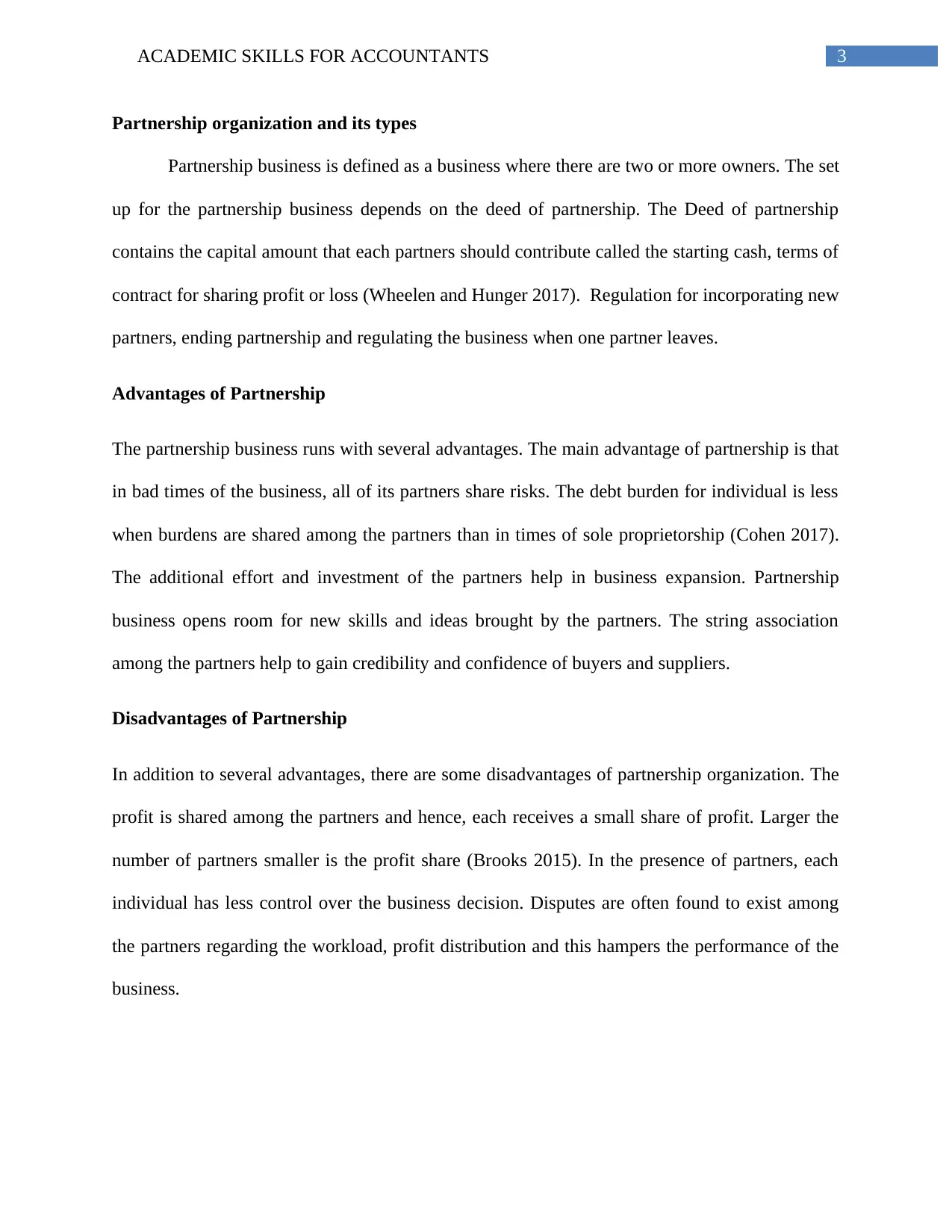
3ACADEMIC SKILLS FOR ACCOUNTANTS
Partnership organization and its types
Partnership business is defined as a business where there are two or more owners. The set
up for the partnership business depends on the deed of partnership. The Deed of partnership
contains the capital amount that each partners should contribute called the starting cash, terms of
contract for sharing profit or loss (Wheelen and Hunger 2017). Regulation for incorporating new
partners, ending partnership and regulating the business when one partner leaves.
Advantages of Partnership
The partnership business runs with several advantages. The main advantage of partnership is that
in bad times of the business, all of its partners share risks. The debt burden for individual is less
when burdens are shared among the partners than in times of sole proprietorship (Cohen 2017).
The additional effort and investment of the partners help in business expansion. Partnership
business opens room for new skills and ideas brought by the partners. The string association
among the partners help to gain credibility and confidence of buyers and suppliers.
Disadvantages of Partnership
In addition to several advantages, there are some disadvantages of partnership organization. The
profit is shared among the partners and hence, each receives a small share of profit. Larger the
number of partners smaller is the profit share (Brooks 2015). In the presence of partners, each
individual has less control over the business decision. Disputes are often found to exist among
the partners regarding the workload, profit distribution and this hampers the performance of the
business.
Partnership organization and its types
Partnership business is defined as a business where there are two or more owners. The set
up for the partnership business depends on the deed of partnership. The Deed of partnership
contains the capital amount that each partners should contribute called the starting cash, terms of
contract for sharing profit or loss (Wheelen and Hunger 2017). Regulation for incorporating new
partners, ending partnership and regulating the business when one partner leaves.
Advantages of Partnership
The partnership business runs with several advantages. The main advantage of partnership is that
in bad times of the business, all of its partners share risks. The debt burden for individual is less
when burdens are shared among the partners than in times of sole proprietorship (Cohen 2017).
The additional effort and investment of the partners help in business expansion. Partnership
business opens room for new skills and ideas brought by the partners. The string association
among the partners help to gain credibility and confidence of buyers and suppliers.
Disadvantages of Partnership
In addition to several advantages, there are some disadvantages of partnership organization. The
profit is shared among the partners and hence, each receives a small share of profit. Larger the
number of partners smaller is the profit share (Brooks 2015). In the presence of partners, each
individual has less control over the business decision. Disputes are often found to exist among
the partners regarding the workload, profit distribution and this hampers the performance of the
business.
Paraphrase This Document
Need a fresh take? Get an instant paraphrase of this document with our AI Paraphraser
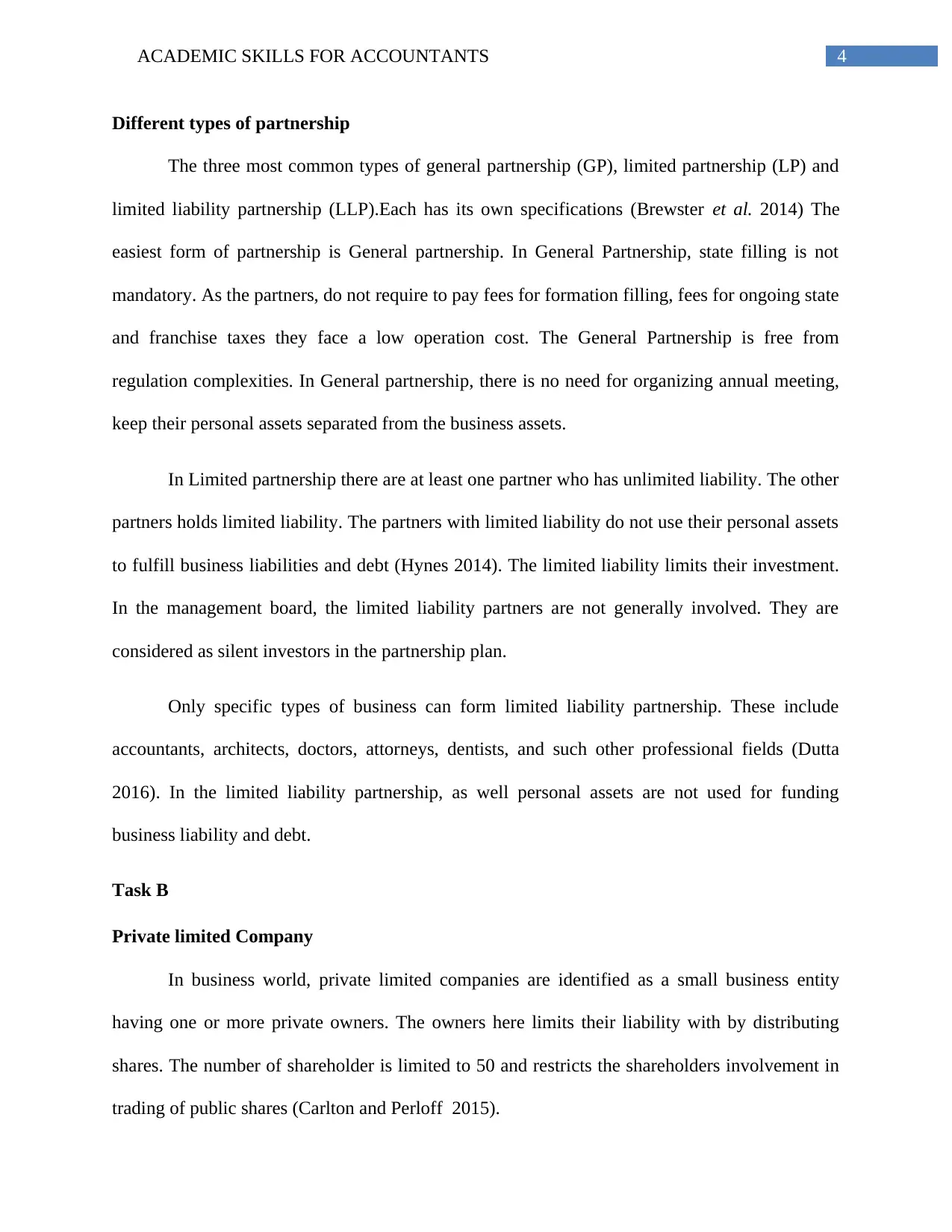
4ACADEMIC SKILLS FOR ACCOUNTANTS
Different types of partnership
The three most common types of general partnership (GP), limited partnership (LP) and
limited liability partnership (LLP).Each has its own specifications (Brewster et al. 2014) The
easiest form of partnership is General partnership. In General Partnership, state filling is not
mandatory. As the partners, do not require to pay fees for formation filling, fees for ongoing state
and franchise taxes they face a low operation cost. The General Partnership is free from
regulation complexities. In General partnership, there is no need for organizing annual meeting,
keep their personal assets separated from the business assets.
In Limited partnership there are at least one partner who has unlimited liability. The other
partners holds limited liability. The partners with limited liability do not use their personal assets
to fulfill business liabilities and debt (Hynes 2014). The limited liability limits their investment.
In the management board, the limited liability partners are not generally involved. They are
considered as silent investors in the partnership plan.
Only specific types of business can form limited liability partnership. These include
accountants, architects, doctors, attorneys, dentists, and such other professional fields (Dutta
2016). In the limited liability partnership, as well personal assets are not used for funding
business liability and debt.
Task B
Private limited Company
In business world, private limited companies are identified as a small business entity
having one or more private owners. The owners here limits their liability with by distributing
shares. The number of shareholder is limited to 50 and restricts the shareholders involvement in
trading of public shares (Carlton and Perloff 2015).
Different types of partnership
The three most common types of general partnership (GP), limited partnership (LP) and
limited liability partnership (LLP).Each has its own specifications (Brewster et al. 2014) The
easiest form of partnership is General partnership. In General Partnership, state filling is not
mandatory. As the partners, do not require to pay fees for formation filling, fees for ongoing state
and franchise taxes they face a low operation cost. The General Partnership is free from
regulation complexities. In General partnership, there is no need for organizing annual meeting,
keep their personal assets separated from the business assets.
In Limited partnership there are at least one partner who has unlimited liability. The other
partners holds limited liability. The partners with limited liability do not use their personal assets
to fulfill business liabilities and debt (Hynes 2014). The limited liability limits their investment.
In the management board, the limited liability partners are not generally involved. They are
considered as silent investors in the partnership plan.
Only specific types of business can form limited liability partnership. These include
accountants, architects, doctors, attorneys, dentists, and such other professional fields (Dutta
2016). In the limited liability partnership, as well personal assets are not used for funding
business liability and debt.
Task B
Private limited Company
In business world, private limited companies are identified as a small business entity
having one or more private owners. The owners here limits their liability with by distributing
shares. The number of shareholder is limited to 50 and restricts the shareholders involvement in
trading of public shares (Carlton and Perloff 2015).
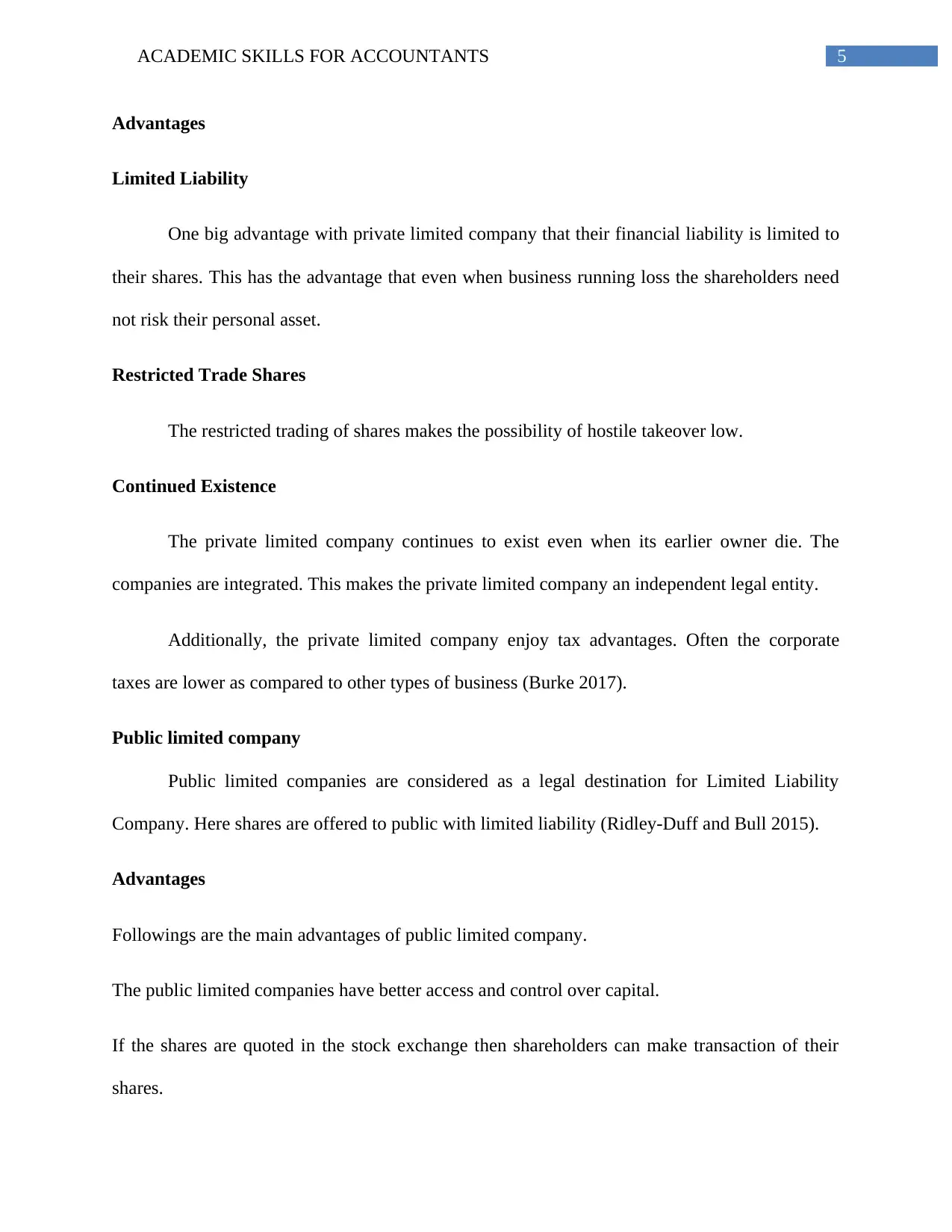
5ACADEMIC SKILLS FOR ACCOUNTANTS
Advantages
Limited Liability
One big advantage with private limited company that their financial liability is limited to
their shares. This has the advantage that even when business running loss the shareholders need
not risk their personal asset.
Restricted Trade Shares
The restricted trading of shares makes the possibility of hostile takeover low.
Continued Existence
The private limited company continues to exist even when its earlier owner die. The
companies are integrated. This makes the private limited company an independent legal entity.
Additionally, the private limited company enjoy tax advantages. Often the corporate
taxes are lower as compared to other types of business (Burke 2017).
Public limited company
Public limited companies are considered as a legal destination for Limited Liability
Company. Here shares are offered to public with limited liability (Ridley-Duff and Bull 2015).
Advantages
Followings are the main advantages of public limited company.
The public limited companies have better access and control over capital.
If the shares are quoted in the stock exchange then shareholders can make transaction of their
shares.
Advantages
Limited Liability
One big advantage with private limited company that their financial liability is limited to
their shares. This has the advantage that even when business running loss the shareholders need
not risk their personal asset.
Restricted Trade Shares
The restricted trading of shares makes the possibility of hostile takeover low.
Continued Existence
The private limited company continues to exist even when its earlier owner die. The
companies are integrated. This makes the private limited company an independent legal entity.
Additionally, the private limited company enjoy tax advantages. Often the corporate
taxes are lower as compared to other types of business (Burke 2017).
Public limited company
Public limited companies are considered as a legal destination for Limited Liability
Company. Here shares are offered to public with limited liability (Ridley-Duff and Bull 2015).
Advantages
Followings are the main advantages of public limited company.
The public limited companies have better access and control over capital.
If the shares are quoted in the stock exchange then shareholders can make transaction of their
shares.
⊘ This is a preview!⊘
Do you want full access?
Subscribe today to unlock all pages.

Trusted by 1+ million students worldwide
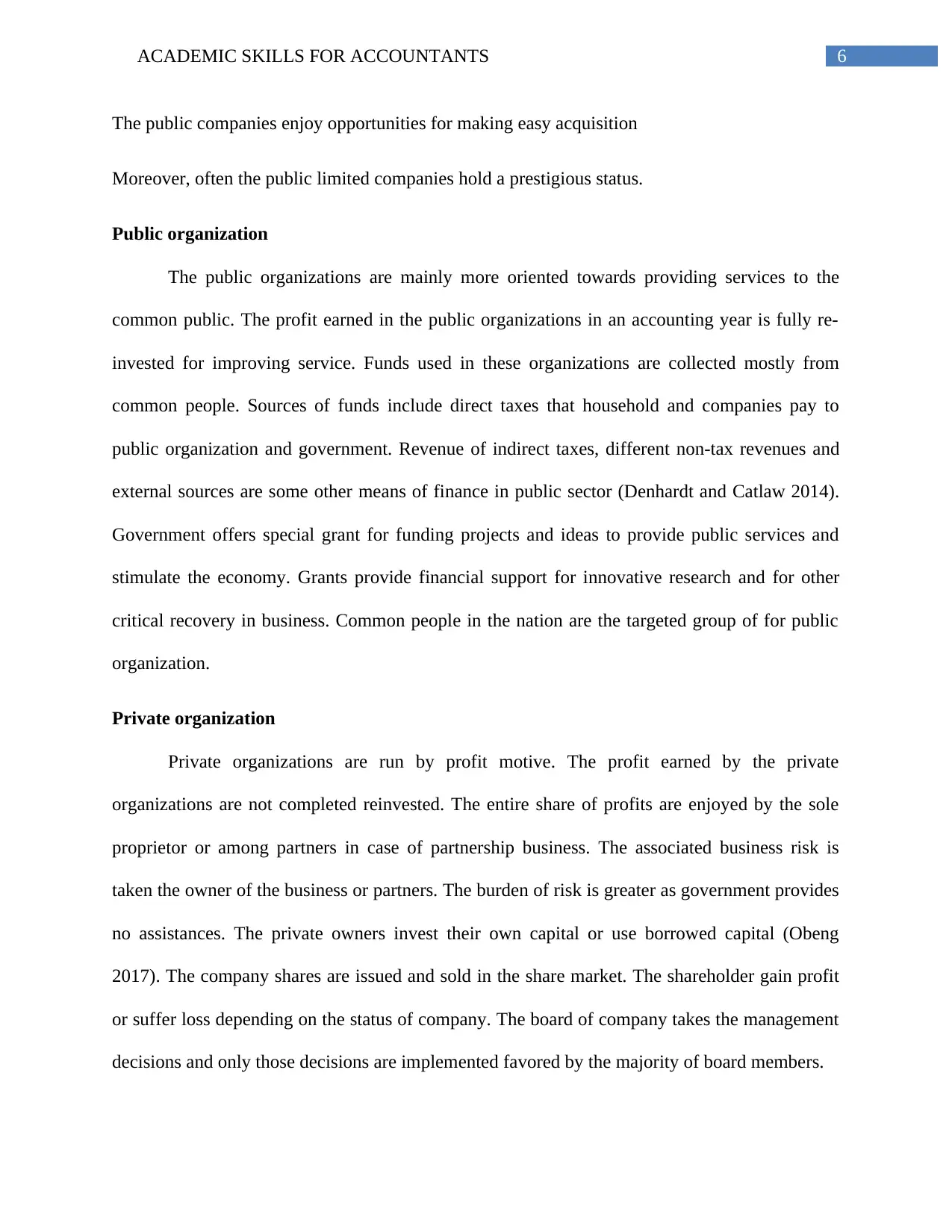
6ACADEMIC SKILLS FOR ACCOUNTANTS
The public companies enjoy opportunities for making easy acquisition
Moreover, often the public limited companies hold a prestigious status.
Public organization
The public organizations are mainly more oriented towards providing services to the
common public. The profit earned in the public organizations in an accounting year is fully re-
invested for improving service. Funds used in these organizations are collected mostly from
common people. Sources of funds include direct taxes that household and companies pay to
public organization and government. Revenue of indirect taxes, different non-tax revenues and
external sources are some other means of finance in public sector (Denhardt and Catlaw 2014).
Government offers special grant for funding projects and ideas to provide public services and
stimulate the economy. Grants provide financial support for innovative research and for other
critical recovery in business. Common people in the nation are the targeted group of for public
organization.
Private organization
Private organizations are run by profit motive. The profit earned by the private
organizations are not completed reinvested. The entire share of profits are enjoyed by the sole
proprietor or among partners in case of partnership business. The associated business risk is
taken the owner of the business or partners. The burden of risk is greater as government provides
no assistances. The private owners invest their own capital or use borrowed capital (Obeng
2017). The company shares are issued and sold in the share market. The shareholder gain profit
or suffer loss depending on the status of company. The board of company takes the management
decisions and only those decisions are implemented favored by the majority of board members.
The public companies enjoy opportunities for making easy acquisition
Moreover, often the public limited companies hold a prestigious status.
Public organization
The public organizations are mainly more oriented towards providing services to the
common public. The profit earned in the public organizations in an accounting year is fully re-
invested for improving service. Funds used in these organizations are collected mostly from
common people. Sources of funds include direct taxes that household and companies pay to
public organization and government. Revenue of indirect taxes, different non-tax revenues and
external sources are some other means of finance in public sector (Denhardt and Catlaw 2014).
Government offers special grant for funding projects and ideas to provide public services and
stimulate the economy. Grants provide financial support for innovative research and for other
critical recovery in business. Common people in the nation are the targeted group of for public
organization.
Private organization
Private organizations are run by profit motive. The profit earned by the private
organizations are not completed reinvested. The entire share of profits are enjoyed by the sole
proprietor or among partners in case of partnership business. The associated business risk is
taken the owner of the business or partners. The burden of risk is greater as government provides
no assistances. The private owners invest their own capital or use borrowed capital (Obeng
2017). The company shares are issued and sold in the share market. The shareholder gain profit
or suffer loss depending on the status of company. The board of company takes the management
decisions and only those decisions are implemented favored by the majority of board members.
Paraphrase This Document
Need a fresh take? Get an instant paraphrase of this document with our AI Paraphraser
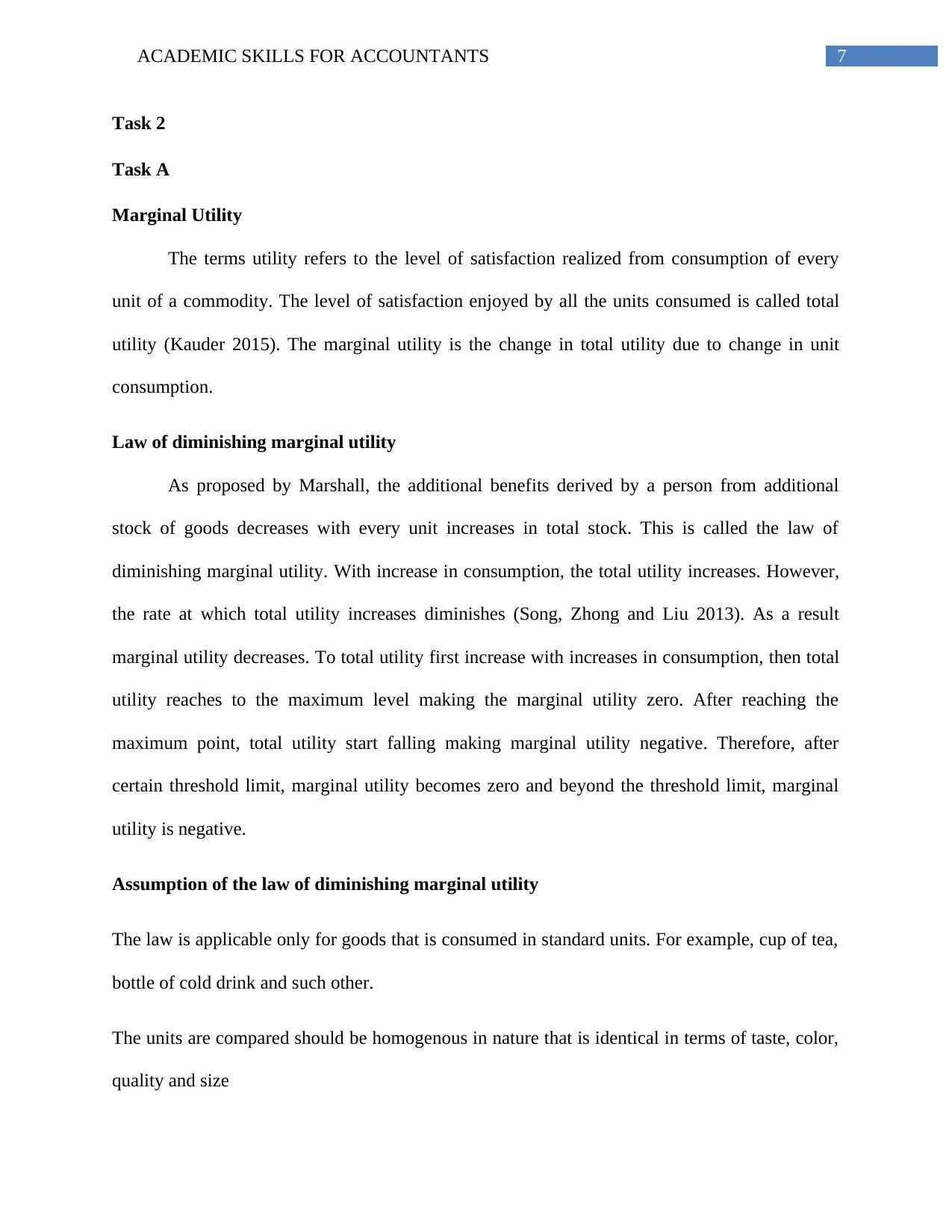
7ACADEMIC SKILLS FOR ACCOUNTANTS
Task 2
Task A
Marginal Utility
The terms utility refers to the level of satisfaction realized from consumption of every
unit of a commodity. The level of satisfaction enjoyed by all the units consumed is called total
utility (Kauder 2015). The marginal utility is the change in total utility due to change in unit
consumption.
Law of diminishing marginal utility
As proposed by Marshall, the additional benefits derived by a person from additional
stock of goods decreases with every unit increases in total stock. This is called the law of
diminishing marginal utility. With increase in consumption, the total utility increases. However,
the rate at which total utility increases diminishes (Song, Zhong and Liu 2013). As a result
marginal utility decreases. To total utility first increase with increases in consumption, then total
utility reaches to the maximum level making the marginal utility zero. After reaching the
maximum point, total utility start falling making marginal utility negative. Therefore, after
certain threshold limit, marginal utility becomes zero and beyond the threshold limit, marginal
utility is negative.
Assumption of the law of diminishing marginal utility
The law is applicable only for goods that is consumed in standard units. For example, cup of tea,
bottle of cold drink and such other.
The units are compared should be homogenous in nature that is identical in terms of taste, color,
quality and size
Task 2
Task A
Marginal Utility
The terms utility refers to the level of satisfaction realized from consumption of every
unit of a commodity. The level of satisfaction enjoyed by all the units consumed is called total
utility (Kauder 2015). The marginal utility is the change in total utility due to change in unit
consumption.
Law of diminishing marginal utility
As proposed by Marshall, the additional benefits derived by a person from additional
stock of goods decreases with every unit increases in total stock. This is called the law of
diminishing marginal utility. With increase in consumption, the total utility increases. However,
the rate at which total utility increases diminishes (Song, Zhong and Liu 2013). As a result
marginal utility decreases. To total utility first increase with increases in consumption, then total
utility reaches to the maximum level making the marginal utility zero. After reaching the
maximum point, total utility start falling making marginal utility negative. Therefore, after
certain threshold limit, marginal utility becomes zero and beyond the threshold limit, marginal
utility is negative.
Assumption of the law of diminishing marginal utility
The law is applicable only for goods that is consumed in standard units. For example, cup of tea,
bottle of cold drink and such other.
The units are compared should be homogenous in nature that is identical in terms of taste, color,
quality and size
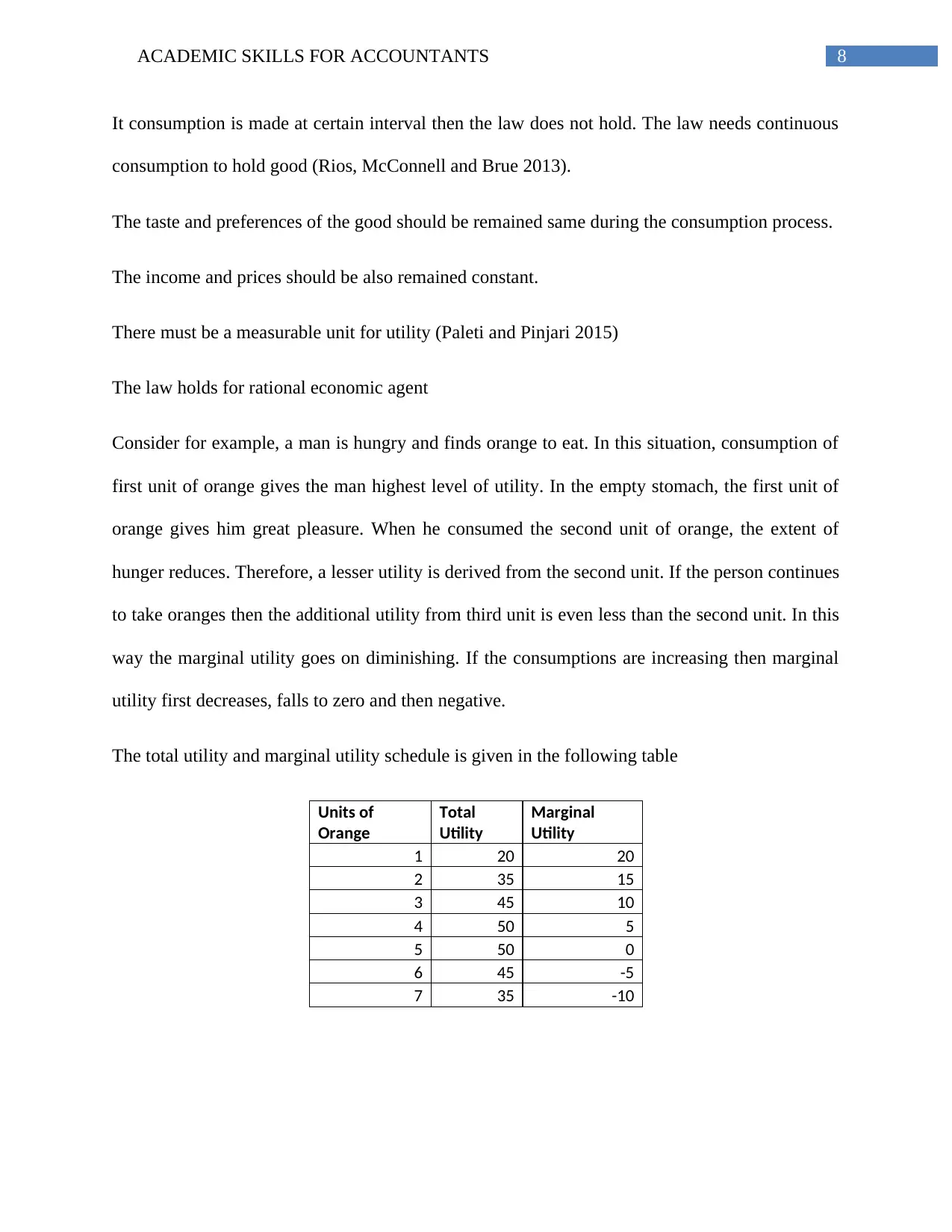
8ACADEMIC SKILLS FOR ACCOUNTANTS
It consumption is made at certain interval then the law does not hold. The law needs continuous
consumption to hold good (Rios, McConnell and Brue 2013).
The taste and preferences of the good should be remained same during the consumption process.
The income and prices should be also remained constant.
There must be a measurable unit for utility (Paleti and Pinjari 2015)
The law holds for rational economic agent
Consider for example, a man is hungry and finds orange to eat. In this situation, consumption of
first unit of orange gives the man highest level of utility. In the empty stomach, the first unit of
orange gives him great pleasure. When he consumed the second unit of orange, the extent of
hunger reduces. Therefore, a lesser utility is derived from the second unit. If the person continues
to take oranges then the additional utility from third unit is even less than the second unit. In this
way the marginal utility goes on diminishing. If the consumptions are increasing then marginal
utility first decreases, falls to zero and then negative.
The total utility and marginal utility schedule is given in the following table
Units of
Orange
Total
Utility
Marginal
Utility
1 20 20
2 35 15
3 45 10
4 50 5
5 50 0
6 45 -5
7 35 -10
It consumption is made at certain interval then the law does not hold. The law needs continuous
consumption to hold good (Rios, McConnell and Brue 2013).
The taste and preferences of the good should be remained same during the consumption process.
The income and prices should be also remained constant.
There must be a measurable unit for utility (Paleti and Pinjari 2015)
The law holds for rational economic agent
Consider for example, a man is hungry and finds orange to eat. In this situation, consumption of
first unit of orange gives the man highest level of utility. In the empty stomach, the first unit of
orange gives him great pleasure. When he consumed the second unit of orange, the extent of
hunger reduces. Therefore, a lesser utility is derived from the second unit. If the person continues
to take oranges then the additional utility from third unit is even less than the second unit. In this
way the marginal utility goes on diminishing. If the consumptions are increasing then marginal
utility first decreases, falls to zero and then negative.
The total utility and marginal utility schedule is given in the following table
Units of
Orange
Total
Utility
Marginal
Utility
1 20 20
2 35 15
3 45 10
4 50 5
5 50 0
6 45 -5
7 35 -10
⊘ This is a preview!⊘
Do you want full access?
Subscribe today to unlock all pages.

Trusted by 1+ million students worldwide
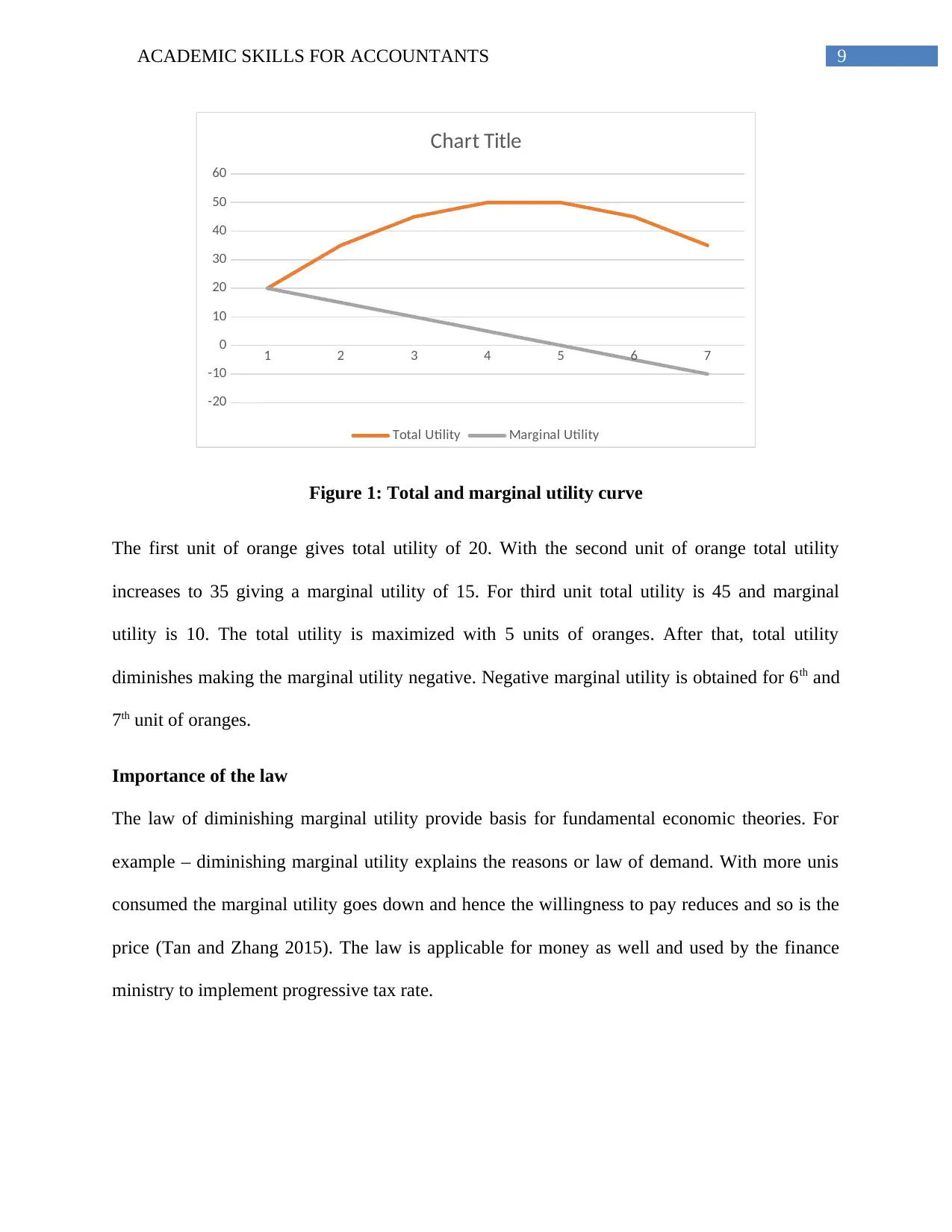
9ACADEMIC SKILLS FOR ACCOUNTANTS
1 2 3 4 5 6 7
-20
-10
0
10
20
30
40
50
60
Chart Title
Total Utility Marginal Utility
Figure 1: Total and marginal utility curve
The first unit of orange gives total utility of 20. With the second unit of orange total utility
increases to 35 giving a marginal utility of 15. For third unit total utility is 45 and marginal
utility is 10. The total utility is maximized with 5 units of oranges. After that, total utility
diminishes making the marginal utility negative. Negative marginal utility is obtained for 6th and
7th unit of oranges.
Importance of the law
The law of diminishing marginal utility provide basis for fundamental economic theories. For
example – diminishing marginal utility explains the reasons or law of demand. With more unis
consumed the marginal utility goes down and hence the willingness to pay reduces and so is the
price (Tan and Zhang 2015). The law is applicable for money as well and used by the finance
ministry to implement progressive tax rate.
1 2 3 4 5 6 7
-20
-10
0
10
20
30
40
50
60
Chart Title
Total Utility Marginal Utility
Figure 1: Total and marginal utility curve
The first unit of orange gives total utility of 20. With the second unit of orange total utility
increases to 35 giving a marginal utility of 15. For third unit total utility is 45 and marginal
utility is 10. The total utility is maximized with 5 units of oranges. After that, total utility
diminishes making the marginal utility negative. Negative marginal utility is obtained for 6th and
7th unit of oranges.
Importance of the law
The law of diminishing marginal utility provide basis for fundamental economic theories. For
example – diminishing marginal utility explains the reasons or law of demand. With more unis
consumed the marginal utility goes down and hence the willingness to pay reduces and so is the
price (Tan and Zhang 2015). The law is applicable for money as well and used by the finance
ministry to implement progressive tax rate.
Paraphrase This Document
Need a fresh take? Get an instant paraphrase of this document with our AI Paraphraser
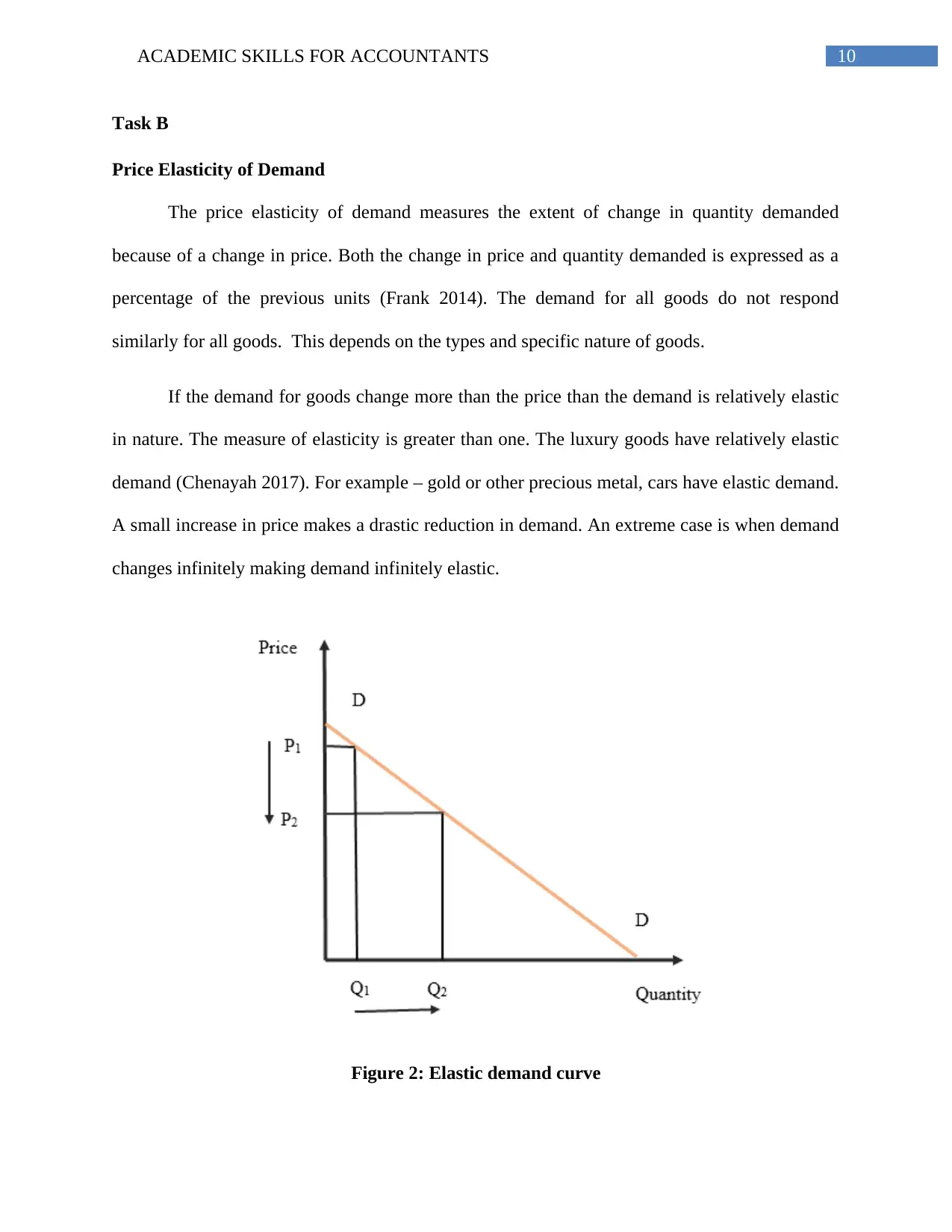
10ACADEMIC SKILLS FOR ACCOUNTANTS
Task B
Price Elasticity of Demand
The price elasticity of demand measures the extent of change in quantity demanded
because of a change in price. Both the change in price and quantity demanded is expressed as a
percentage of the previous units (Frank 2014). The demand for all goods do not respond
similarly for all goods. This depends on the types and specific nature of goods.
If the demand for goods change more than the price than the demand is relatively elastic
in nature. The measure of elasticity is greater than one. The luxury goods have relatively elastic
demand (Chenayah 2017). For example – gold or other precious metal, cars have elastic demand.
A small increase in price makes a drastic reduction in demand. An extreme case is when demand
changes infinitely making demand infinitely elastic.
Figure 2: Elastic demand curve
Task B
Price Elasticity of Demand
The price elasticity of demand measures the extent of change in quantity demanded
because of a change in price. Both the change in price and quantity demanded is expressed as a
percentage of the previous units (Frank 2014). The demand for all goods do not respond
similarly for all goods. This depends on the types and specific nature of goods.
If the demand for goods change more than the price than the demand is relatively elastic
in nature. The measure of elasticity is greater than one. The luxury goods have relatively elastic
demand (Chenayah 2017). For example – gold or other precious metal, cars have elastic demand.
A small increase in price makes a drastic reduction in demand. An extreme case is when demand
changes infinitely making demand infinitely elastic.
Figure 2: Elastic demand curve
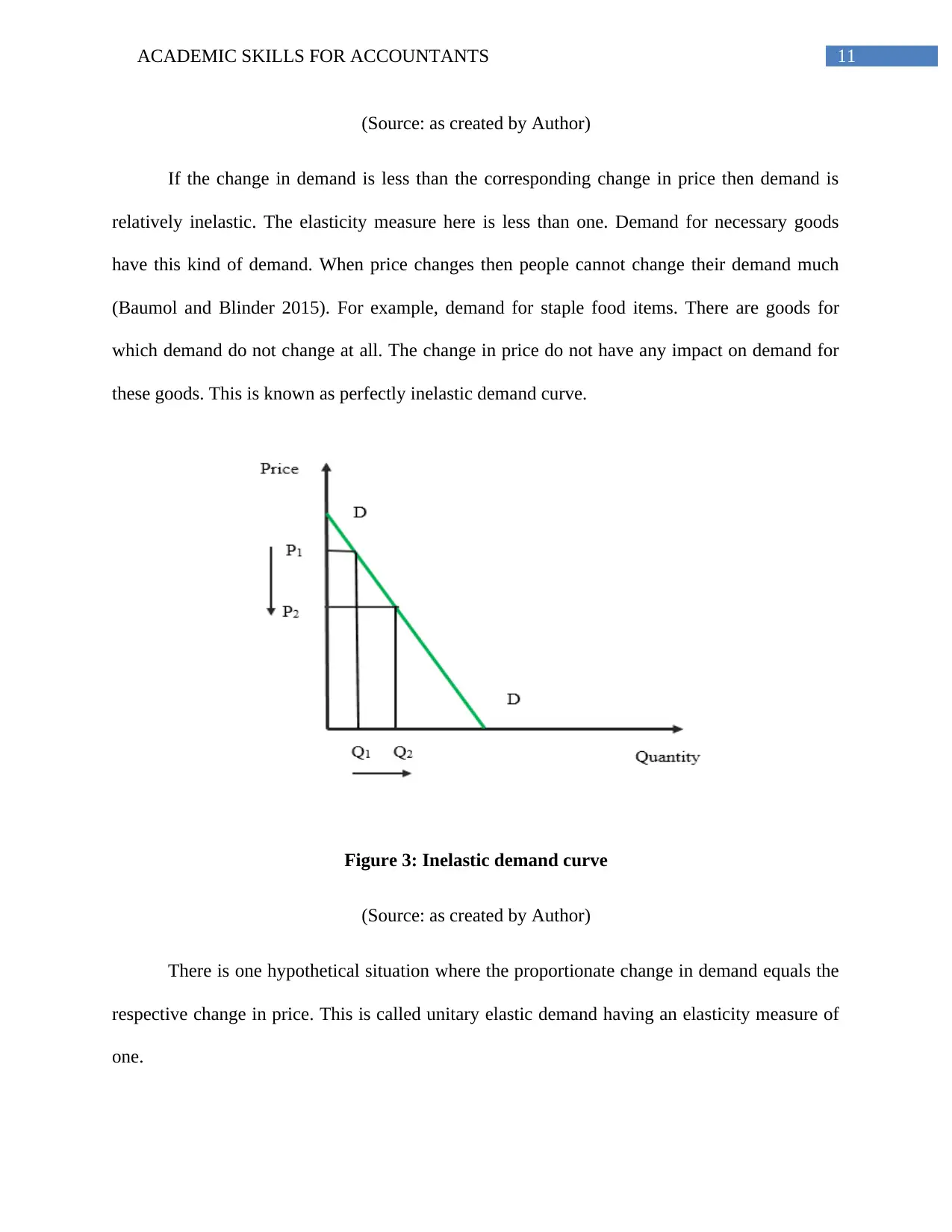
11ACADEMIC SKILLS FOR ACCOUNTANTS
(Source: as created by Author)
If the change in demand is less than the corresponding change in price then demand is
relatively inelastic. The elasticity measure here is less than one. Demand for necessary goods
have this kind of demand. When price changes then people cannot change their demand much
(Baumol and Blinder 2015). For example, demand for staple food items. There are goods for
which demand do not change at all. The change in price do not have any impact on demand for
these goods. This is known as perfectly inelastic demand curve.
Figure 3: Inelastic demand curve
(Source: as created by Author)
There is one hypothetical situation where the proportionate change in demand equals the
respective change in price. This is called unitary elastic demand having an elasticity measure of
one.
(Source: as created by Author)
If the change in demand is less than the corresponding change in price then demand is
relatively inelastic. The elasticity measure here is less than one. Demand for necessary goods
have this kind of demand. When price changes then people cannot change their demand much
(Baumol and Blinder 2015). For example, demand for staple food items. There are goods for
which demand do not change at all. The change in price do not have any impact on demand for
these goods. This is known as perfectly inelastic demand curve.
Figure 3: Inelastic demand curve
(Source: as created by Author)
There is one hypothetical situation where the proportionate change in demand equals the
respective change in price. This is called unitary elastic demand having an elasticity measure of
one.
⊘ This is a preview!⊘
Do you want full access?
Subscribe today to unlock all pages.

Trusted by 1+ million students worldwide
1 out of 15
Related Documents
Your All-in-One AI-Powered Toolkit for Academic Success.
+13062052269
info@desklib.com
Available 24*7 on WhatsApp / Email
![[object Object]](/_next/static/media/star-bottom.7253800d.svg)
Unlock your academic potential
Copyright © 2020–2025 A2Z Services. All Rights Reserved. Developed and managed by ZUCOL.




